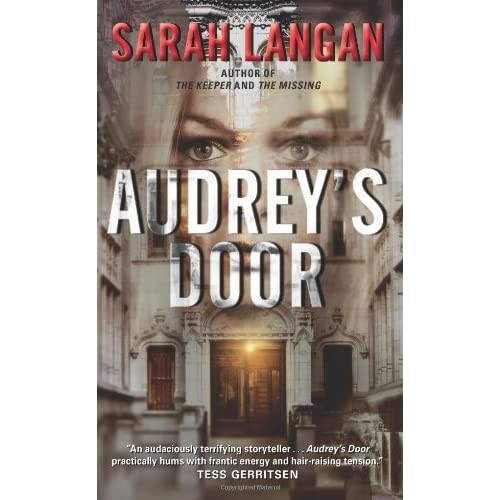Audrey's Door / Sarah Langan
 Harper / September 2009
Harper / September 2009
Reviewed by: Vince A. Liaguno
Inexplicably, Audrey’s Door – Sarah Langan’s Bram Stoker Award-winning third novel – has languished in my to-be-read pile for far too long until recently. I claim inexplicability because I fell head over heels in love with Langan’s work after The Keeper (2006) and its sequel-of-sorts, The Missing (2007), so it’s a bit of a mystery why I hadn’t moved this one to the top of the pile long ago.
The titular character – surname Lucas – moves into an apartment building called The Breviary. Intrigued by the building’s rare Chaotic Naturalism architecture and drawn to its bargain-basement rent, Audrey seems willing to overlook the fact that the previous tenant in 14B – a famed opera singer – drowned her four children in the apartment’s bathtub before slitting her own wrists. It isn’t long before the haunted apartment building and its creepy denizens – think Rosemary’s Baby meets Cocoon here – begin to command the rising architect to build a mysterious door. As Audrey’s Woody Allen-esque neuroses and obsessive compulsions ramp up to full-tilt, she – and the reader – begin to question her sanity.
Audrey’s Door is an interesting departure from the author’s previous efforts. Whereas both The Keeper and The Missing had a strong, almost claustrophobic sense of place from which the characters had little respite, Audrey’s Door doesn’t immediately give the reader a sense that its characters are trapped or even in grave danger until well into the third act. Despite increasingly outlandish, hallucinogenic nightmares and a sense that she’s losing control, Audrey never seems confined by the building. Her freedom to go to work, travel cross-country to Nebraska to tend to an ailing relative, and even traverse the city mid-hurricane detracts somewhat from that sense of physical isolation that so marvelously plagued the characters in her first two novels.
But Langan gives the reader a sense of a very different kind of isolation, one that’s less physical and more cerebral, by imbuing her story with the overriding theme of holding on to things that should be long let go of. The notion that what holds us back is a sometimes the overwhelming inability to get out of our own heads drives much of the conflict in Audrey’s Door. The result is paradoxical; the physical haunting caused by The Breviary almost takes a back-seat to the characters’ internal struggles. This lessens the traditional horror elements of the story, yet strengthens the subtler, more universal horrors within the characters themselves giving a more immediate, less fantastical sense of relatability to the characters’ plight. Audrey, a fully-drawn, beautifully flawed heroine, is holding on to her mother – both in memories and the physical sense. Her boyfriend, Saraub, is holding on to a dead-on-arrival documentary project, while his mother stubbornly clings to outdated cultural traditions that prevent her from accepting Audrey and strain relations with her only son. Audrey’s boss at the architecture firm holds on to crippling guilt and regrets about her abilities as a mother in the face of a family tragedy. New friend and fellow Breviary dweller Jayne holds on to long-standing insecurities. Even the kooky assortment of tenants who populate The Breviary are desperately holding on to their youth to grotesque effect. So, while The Breviary is busy exercising its own literal demons, each character finds either doom or redemption by confronting their own.
Langan wisely opts to make The Breviary a character onto itself, both endowing the apartment building with a rich and colorful sense of history and personifying its physical structure to such a degree that it appears to live and breathe. This allows the building itself to be more an active participant in the hauntings it inflicts on others versus remaining a mere receptacle for the malevolence at the center of its history:
It happened so slowly at first, none of them noticed. The walls hummed. The stained-glass birds and mosaics sometimes took flight. The hallways constricted like throats. Hinges creaked. Nightmares flew loose from their authors and inhabited the building like cold air.
That Langan’s work skews heavier toward the more literary leanings of Peter Straub versus the more mass market trappings of, say, Bentley Little makes it easier to overlook the fact that this is dark fiction in which the rewards come in subtle, character-driven moments versus a series of grisly set pieces or overt shock. Although Audrey’s Door lacks some of the creepier horror elements that permeated both The Keeper and The Missing, the tremendous humanity with which Langan draws even the most minor of characters will enthrall. Read a chapter like “Baby’s Breath” in which one of the characters meanders through the house late at night considering each member of her family and you’ll quickly find yourself pleasantly disoriented, as if you’ve stumbled into a gorgeous piece of literary fiction of the highest caliber.
Audrey’s Door may be indicative of Langan’s greatest strength as a dark scribe: Elevating what’s essentially a tried-and-true horror story at its core to a wholly unique literary hybrid that almost defies categorization.
Purchase Audrey’s Door by Sarah Langan.



